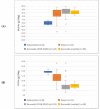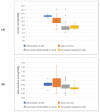Comparative Evaluation of Different Targeted and Untargeted Analytical Approaches to Assess Greek Extra Virgin Olive Oil Quality and Authentication
- PMID: 35209139
- PMCID: PMC8874659
- DOI: 10.3390/molecules27041350
Comparative Evaluation of Different Targeted and Untargeted Analytical Approaches to Assess Greek Extra Virgin Olive Oil Quality and Authentication
Abstract
Extra virgin olive oil (EVOO) is a key component of the Mediterranean diet, with several health benefits derived from its consumption. Moreover, due to its eminent market position, EVOO has been thoroughly studied over the last several years, aiming at its authentication, but also to reveal the chemical profile inherent to its beneficial properties. In the present work, a comparative study was conducted to assess Greek EVOOs' quality and authentication utilizing different analytical approaches, both targeted and untargeted. 173 monovarietal EVOOs from three emblematic Greek cultivars (Koroneiki, Kolovi and Adramytiani), obtained during the harvesting years of 2018-2020, were analyzed and quantified as per their fatty acids methyl esters (FAMEs) composition via the official method (EEC) No 2568/91, as well as their bioactive content through liquid chromatography coupled to high resolution mass spectrometry (LC-HRMS) methodology. In addition to FAMEs analysis, EVOO samples were also analyzed via HRMS-untargeted metabolomics and optical spectroscopy techniques (visible absorption, fluorescence and Raman). The data retrieved from all applied techniques were analyzed with Machine Learning methods for the authentication of the EVOOs' variety. The models' predictive performance was calculated through test samples, while for further evaluation 30 commercially available EVOO samples were also examined in terms of variety. To the best of our knowledge, this is the first study where different techniques from the fields of standard analysis, spectrometry and optical spectroscopy are applied to the same EVOO samples, providing strong insight into EVOOs chemical profile and a comparative evaluation through the different platforms.
Keywords: FAMEs; HRMS; Raman; authenticity; extra virgin olive oil; fluorescence; machine learning; metabolomics; optical spectroscopy; variety identification; visible absorption.
Conflict of interest statement
The authors declare no conflict of interest. The funders had no role in the design of the study; in the collection, analyses, or interpretation of data; in the writing of the manuscript, or in the decision to publish the results.
Figures








References
-
- EC COMMISSION REGULATION (EEC) No 2568/91 of 11 July 1991 on the Characteristics of Olive Oil and Olive-Residue Oil and on the Relevant Methods of Analysis. European Commission; Brussels, Belgium: 1991.
-
- Covas M.I., De La Torre K., Farré-Albaladejo M., Kaikkonen J., Fitó M., López-Sabater C., Pujadas-Bastardes M.A., Joglar J., Weinbrenner T., Lamuela-Raventós R.M., et al. Postprandial LDL phenolic content and LDL oxidation are modulated by olive oil phenolic compounds in humans. Free Radic. Biol. Med. 2006;40:608–616. doi: 10.1016/j.freeradbiomed.2005.09.027. - DOI - PubMed
-
- Mayneris-Perxachs J., Sala-Vila A., Chisaguano M., Castellote A.I., Estruch R., Covas M.I., Fitó M., Salas-Salvadó J., Martínez-González M.A., Lamuela-Raventós R., et al. Effects of 1-year intervention with a Mediterranean diet on plasma fatty acid composition and metabolic syndrome in a population at high cardiovascular risk. PLoS ONE. 2014;9:e85202. doi: 10.1371/journal.pone.0085202. - DOI - PMC - PubMed
-
- European Parliament & Council Regulation (EC) 1924/2006 on nutrition and health claims made on foods. Off. J. Eur. Communities. 2006;L404:1–15.
MeSH terms
Substances
Grants and funding
LinkOut - more resources
Full Text Sources

